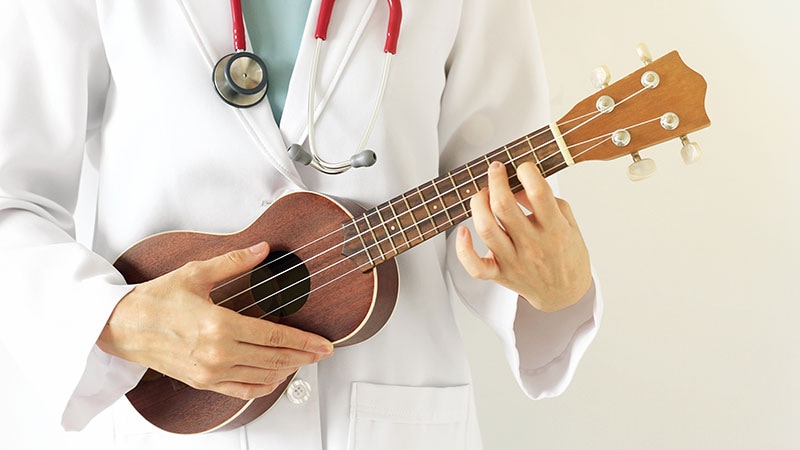Tango, a rhythmic partner dance that enhances balance and coordination, can help ease the symptoms of Parkinson’s disease. Choral singing, which combines vocal training and social interaction, may reduce depression in individuals with dementia. Music therapy has been shown to support stroke recovery by improving speech disorders.
Many clinics in Germany have incorporated music therapy to address mental and physical health conditions. “There is good evidence of effectiveness,” said Lutz Neugebauer, PhD, chairman of the German Music Therapy Society and co-organiser of the 13th European Music Therapy Congress, themed “Bridges,” during an online press briefing.
He noted that since Germany last hosted an international music therapy congress in 1996, nearly 9000 music therapy-related articles have been published in PubMed, including 1500 randomised controlled trials and 360 systematic reviews and meta-analyses.
Germany’s clinical guidelines on dementia, which reflect the highest level of evidence-based medical recommendations, endorse music therapy to ease symptoms such as anxiety, restlessness, and apathy. Music therapy is also included in 37 national clinical guidelines in Germany published by the Association of Scientific Medical Societies, 29 of which follow the country’s highest standard for evidence-based care.
“There is an impressive wealth of evidence,” said Sabine C. Koch, PhD, professor of empirical research in the arts therapies at Alanus University of Arts and Social Sciences in Alfter, Germany. She outlined the conditions under which music therapy can complement psychotherapy or pharmacotherapy and its effectiveness.
A recent meta-analysis of the effects of arts-based interventions in the treatment and management of noncommunicable diseases included 150 systematic reviews encompassing 3885 randomised controlled trials. “The results particularly support music and dance therapy,” said Koch. The authors reported small-to-moderate effects for neurologic disorders (standardised mean difference [SMD] = 0.40; 95% CI, 0.30-0.50) and moderate effects for cancer (SMD = 0.52), cardiovascular disease (SMD = 0.52), mental illness (SMD = 0.53), and chronic respiratory disease (SMD = 0.76). However, most of these reviews had low methodologic quality. Still, the authors concluded that “arts-based interventions may be a valuable addition to traditionally first-line treatments.”
Clinical Benefits
Music therapy has been well studied in the context of chronic pain and pain management in patients with advanced cancer. “The overall effect is comparable to opioids, but without unwanted side effects,” Koch said. Music therapy also improves sleep and helps reduce fatigue, anxiety, and depression.
Among newborns, music therapy has been shown to improve oxygen saturation, heart and respiratory rates, sleep duration, body temperature, and systolic and diastolic blood pressure. In premature infants, it also supports the development of a functional brain. Studies have shown positive effects on cardiorespiratory function, pain scores, oxygen saturation, and sleep duration, even during sleep.
“Music therapy helps these children reduce stress and recover,” said Koch.
Neugebauer added that in premature infants, music therapy also strengthens the parent-child bond, “one of the key indicators for better development after a difficult start in life.” Music therapy supports speech development in children with developmental delays.
“Music therapy is particularly effective for adolescents and young adults who have experienced trauma such as domestic violence, during migration, or war,” Neugebauer said. “It enables expression beyond the spoken word and bridges language barriers.” He added that music therapy is often the first-choice approach for individuals struggling to communicate through speech, including those with disabilities.
Oncology and Palliative Use
Koch reported that music therapy has shown significant benefits for people with cancer, including reduced anxiety, depression, pain, fatigue, heart rate, and blood pressure. “The effect is strong and significant,” she said, noting that the outcomes are comparable to those seen with cognitive-behavioural therapy.
Music therapy promotes relaxation and reduces fatigue during palliative care. “Music therapy is an effective treatment with a low dropout rate and improves the well-being of terminally ill patients,” said Koch. “In treating depression and anxiety, it often matches the efficacy of cognitive-behavioural therapy.”
Access Barriers
According to Neugebauer, music therapy is an established part of inpatient care for anxiety, depression, substance use disorders, and the consequences of social isolation. However, music therapy remains excluded from outpatient reimbursements for health insurers.
“This urgently needs to change, particularly in vulnerable groups who depend on this therapy,” he said.
Despite strong scientific evidence and positive clinical experience, calls to establish music therapy as a standard outpatient service are yet to be addressed at the political level, as Neugebauer noted. A 2011 report by Christine Bergmann, a former commissioner for the investigation of child sexual abuse, called for outpatient music therapy to be covered by health insurance.
In 2019, the German Institute for Quality and Efficiency in Health Care reported that access to outpatient treatment remains unequal, with only higher-income individuals being able to afford it.
“In a healthcare system that prioritises outpatient over inpatient care, access to music therapy must be guaranteed for all patients — including in outpatient settings and health insurers must be required to cover the cost,” Neugebauer emphasised.
This story was translated from Medscape’s German edition.
